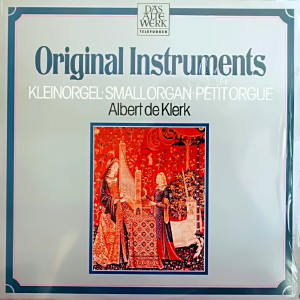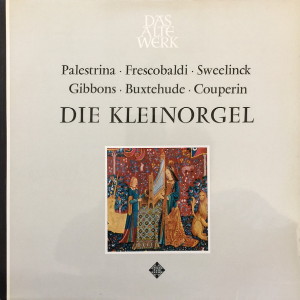 |
1 LP -
Telefunken 6.41036 AP (p) 1961
|
 |
| 1 LP -
Telefunken SAWT 9409-B (p) 1979 |
|
| ORIGINALINSTRUMENTE - Kleinorgel |
|
|
|
|
|
|
|
| Giovanni Pierluigi
da Palestrina (um 1525-1594) |
Ricercare
primi toni
|
(1) |
2' 53" |
A1 |
| Girolamo
Frescobaldi (1583-1643)
|
Hymne "Ave maris
stella"
|
(2) |
3' 34" |
A2 |
| Fray Tomàs de
Santa Maria (1510/20-1570)
|
Fantasia
primi toni - Fantasia
Tertii toni - Fantasia
octavi toni
|
(3) |
3' 40" |
A3 |
| Jan
Pieterszoon Sweelinck (1562-1621)
|
Von der Fortuna
werd' ich getrieben |
(4) |
3' 43" |
A4 |
| Orlando
Gibbons (1583-1625) |
A
Fancy in A |
(5) |
3' 20" |
A5
|
|
The Kingìs Juell |
(5) |
1' 55" |
A6 |
| Narcís
Casanoves (1747-1799)
|
Sonata V |
(6) |
3' 02" |
A7 |
| Domenico
Zipoli (1688-1726) |
Canzona |
(7) |
4' 20" |
B1 |
| Dietrich
Buxtehude
(1637-1707) |
Wie
schön leuchtet der Morgenstern |
(8) |
7' 20" |
B2 |
| Louis
Couperin (um
1626-1661)
|
Chaconne in Ré
mineur |
(9) |
4' 03" |
B3 |
Michel
Corrette (1709-1795)
|
Vous
qui désirez sans fin |
(10) |
6' 41" |
B4 |
|
|
|
|
|
| Albert de KLERK,
Orgel |
(1) - Regal, 16.
Jahrhundert (Orgelbauer unbekannt,
Süddeutscher oder Österreicher, 16.
Jh.)
|
|
|
(2) - Tischorgel,
1684 (Positiv, erbaut von George
Hoad, Bukarest 1684)
|
|
|
(3) - Schreinorgel,
Anfang 18. Jh. (Positiv, Orgelbauer
unbekannt, Deutscher oder
Österreicher, Anfang 18. Jh.)
|
|
|
(4) - Positiv, 17.
Jahrhundert (Orgelbauer unbekannt,
Deutscher oder Österreicher, 17.
Jh.) |
|
|
(5) - Kabinettorgel,
um 1670 (Erbaut von Dr. Bernard
"Father" Smith, um 1670 für New
College, Oxford) |
|
|
(6) -
Secrétaireorgel, um 1785 (Signatur
J. S., vielleicht Johannes
Strumphler, Amsterdam, um 1785) |
|
|
(7) - Kabinettorgel
1784 (Erbaut von Johannes
Strumphler, Amsterdam 1784) |
|
|
(8) - Kabinettorgel,
um 1780 (Holländischer Orgelbauer,
unbekannt, um 1780) |
|
|
(9) - Kabinettorgel,
1772 (Erbaut von Pieter Müller,
1722) |
|
|
(10) -
Kabinettorgel, 1790 (Orgelbauer
unbekannt, um 1790) |
|
5
|
|
|
|
Luogo
e data di registrazione |
|
-
|
|
|
Registrazione:
live / studio |
|
studio |
|
|
Recording
Supervision
|
|
-
|
|
|
Edizione LP |
|
TELEFUNKEN
- 6.41036 AP - (1 LP - durata 44'
31") - (p) 1961 - Analogico |
|
|
Originale LP
|
|
TELEFUNKEN
- SAWT 9409-B - (1 LP - durata 44'
31") - (p) 1961 - Analogico |
|
|
Prima Edizione CD |
|
-
|
|
|
Note |
|
-
|
|
|
|
|
|
The term
”small organ”
covers those
instruments which,
as from about the
14th century,
broke off as
special forms from
the construction
of the church
organ into the
large organ
permanently built
in the church
chancel area and
incorporated into
the architecture.
They survived in
their own rights
in mode of
construction and
function until
into the 18th
century, and
comprised the
portative organ,
the regal organ
and the positive
organ. - The
portative organ,
of which there is
evidence going
back to the 12th
century (not
represented in our
recording), was
the most primitive
of these
instruments. Its
repertoire, like
its technique, was
limited; in the
main it played
monophonically in
courtly and
bourgeois ensemble
music. It played
hardly any role at
all in solo music;
furthermore,
scarcely any
original
instruments of
this kind have
been preserved.
The regal organ
was in evidence as
early as the
middle of the 15th
century and was
first built in
southern Germany;
it remained in use
at least as a
thoroughbass
instrument until
into the 18th
century. From the
very outset it was
a one manual, flat
table instrument
with very short
labial pipes which
produced a sharp
and dry tone.
The taste of the
times was up in
arms against the
”rattling tone” of
this organ until
the progressive
18th century, with
Mattheson, threw
it completely
overboard as being
”highly
repellent”. The
regal was
apparently
significant as a
solo instrument
especially in the
16th century; the
17 th century saw
its grand period
as a thoroughbass
instrument.
The crown of the
small organs is
the positive, a
little, one-manual
organ from which
probably in the
14th century the
continually
expanding large
church music
instrument was
developed. The
early positive had
only flute voices;
as from the 16th
century labial
registers were
added, and more
rarely also a
pedal. The
positive then
developed into the
most versatile,
richly colourful
keyboard
instrument for the
small orchestra,
but especially for
the court, the
great bourgeois
festive hall and
the intimate
bourgeois room.
The 17th and 18th
centuries, as the
golden age of
courtly and
bourgois culture,
was also the
heyday of this
instrument, which
in the diverse
modes of
performance of the
case, table and
cabinet organs,
became an
artistically
ornamented,
representative and
often extremely
valuable piece of
furniture.
|
|
|

